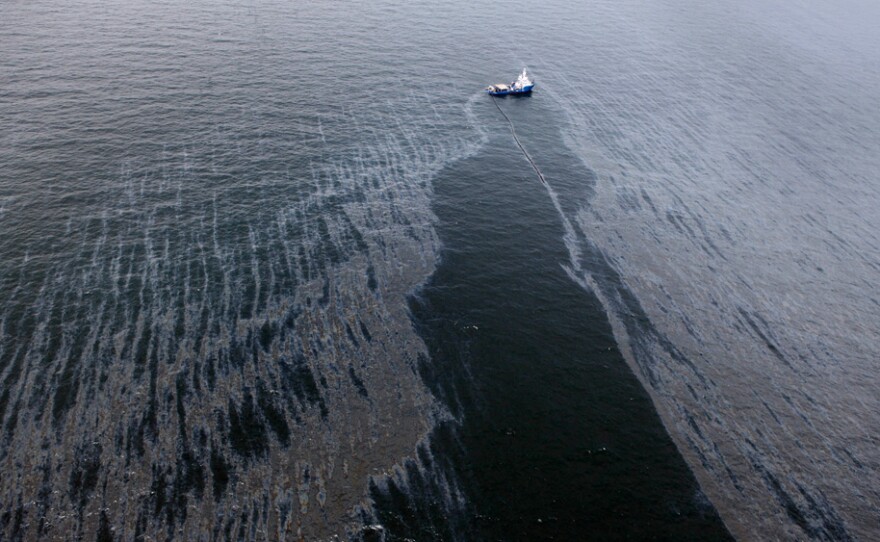One idea being pursued by oil engineers to bring the blowout in the Gulf of Mexico under control is to lower a steel dome the size of a boxcar down to the sea floor to capture oil as it flows out of the broken pipe. But that's a risky proposition in the deep and roiling seas of the Gulf.
In a construction yard in southern Louisiana, engineers are working on a 125-ton steel box, four stories tall, that they hope will stanch the flow of oil from what used to be the Deepwater Horizon rig.
"This is simply large domes, if you will, that would be lowered down on top of the leak and would have a piping system that would carry the oil up to a vessel on the surface," BP spokesman Daren Beaudo said.
The idea is to sink this giant metal box into the mud around the worst of the leaks. The oil would run up a pipe at the top and flow into a tanker when it reaches the surface. Natural gas in the mix would be flared, or burned, once it saw the light of day.
Bud Danenberger, a retired government official who is monitoring the situation closely, says that luckily, there's already a tanker on hand outfitted for these kinds of tasks.
"It will be very well-equipped to handle these volumes," Danenberger said. "It's kind of ideal for this situation."
It is standard work once the oil and gas get to the surface. But getting the dome to settle over the leak is tough. Danenberger says it will also be tricky to keep the pipeline to the surface intact, through 5,000 feet of water.
"Dealing with the currents, weather conditions -- those would be the principal challenges I would see," he said.
The dome technique is in use, but only on small leaks such as in the Santa Barbara Channel. It was pioneered in 1980, when the Ixtoc well, off the coast of Mexico, blew out. The well spewed huge quantities of oil into the Gulf for nine months before they tried using a capture dome like this one.
Danenberger said the technique didn't work too well in that case, but he was more hopeful this time.
"There's certainly some good people working on it, so I'm optimistic," he said.
But even the best-case scenario would be to lower the first dome to the sea floor sometime next week. If that works, at least two others will need to be installed to capture leaks from other sections of pipe. Even then, it's a temporary solution.
BP, in the meantime, is trying to make the leaking oil less hazardous to wildlife. The company is pumping what's essentially detergent deep into the sea to break up the globs of oil near the source.
Piers Chapman, a professor at Texas A&M University, said these chemical dispersants are typically used on oil at the surface.
"Because the well blowout is a mile underwater, dispersing the oil when it's down in the deep Gulf, which is relatively a biological desert, is actually a much better place to do it," Chapman said.
But his technique, like installing domes, is uncharted territory as a spill response.
In the meantime, Beaudo, the BP spokesman, said the company is still using underwater robots to try to shut off the leak by getting the emergency cutoff system, called the blowout preventer, to finally do its job.
"Our objective there, because it is the simplest and most direct way to stop this leak, is to keep working until we are either successful or have exhausted all possibilities," he said.
Outside experts have now seen photos of the malfunctioning blowout preventer, distributed by the Coast Guard.
Robert Bea, a professor at the University of California, Berkeley, said it doesn't look good.
"The existing blowout preventer, from what we can tell, did attempt to do its job," Bea said.
The device attempted to crush the pipe to cut off the leak. Unfortunately, parts of the drilling apparatus, called the drill string, were running inside the pipe at that point, so the pipe couldn't be crimped off neatly. But a BP spokesman said the drill string did not stop the blowout preventer from working. BP is now talking about chopping off the jammed blowout preventer and installing a new one. That would, in the short run at least, create an even bigger gusher on the ocean floor, Bea said.
"That's why it's so chancy," he said.
In any event, BP probably wouldn't be ready to try that for about a month.
Surveying all the options, Texas A&M's Chapman said this much is clear: "It's going to be luck that's involved, as well as technology."
Copyright 2022 NPR. To see more, visit https://www.npr.org. 9(MDAzMjM2NDYzMDEyMzc1Njk5NjAxNzY3OQ001))







